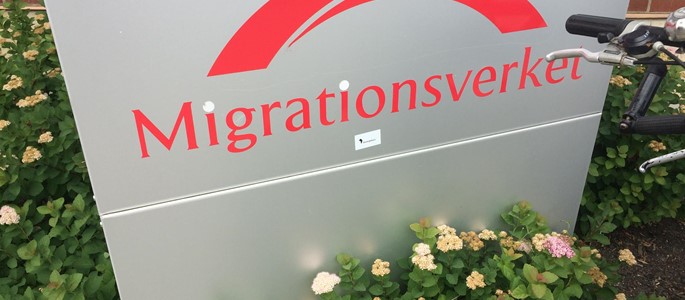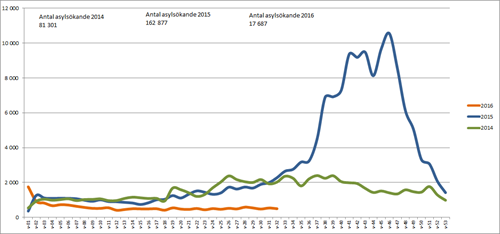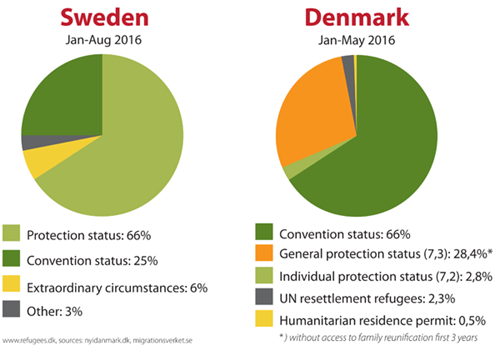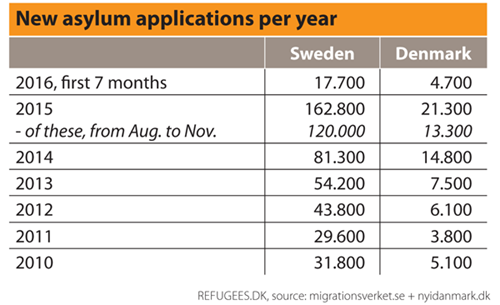Sweden has done a u-turn
First, it was passport control, and now they’ve introduced severe rules for asylum and family reunification
Our neighbor has for many years been known as the stronghold of humanism, and in recent years has been the counterpoint to the increasingly restrictive asylum policies in Denmark. From one day to the next, all this changed when the Swedish government suddenly decided to stop the stream of asylum seekers last November. In panic, ID-control was introduced. In January, this was then expanded to a demand that passports must be displayed and more recently, new and far more severe rules for asylum and family reunification have just been passed. It would seem to have had the desired effect: the number of new asylum seekers coming to Sweden has fallen dramatically. Right now, ca. 500 new applicants come every week, as opposed to the ca. 3,000 per week this time last year. Syrians still make up the bulk of this group.
Newly arrived asylum seekers in Sweden per week
The new rules are far-reaching and on some points, as close to violating accepted conventions as their Danish equivalent. At the same time, living conditions have been radically worsened, waiting times are long and both permanent homes and jobs are difficult to find.
RESTRICTIONS HAVE BEEN ENACTED ON 3 AREAS:
• Rejected asylum seekers are no longer provided with lodgings, food or allowances
• Only refugees with convention status are entitled to family reunification
• Asylum is now only temporary, and limited to either 1 or 3 years, depending on status.
Right now, more than 100,000 are awaiting the outcome of their asylum applications in Sweden and many will be ‘trapped’ by the new rules, which were not in force at the time they came. They have had an expectation that they would get permanent residency in Sweden and that it would be possible to get their family members to join them – both situations will now be impossible for the vast majority.
Until now, regardless of which asylum status a person had, it was possible to get their immediate family to Sweden and, in certain cases, also other family members. This right will now only apply to the refugees who are granted convention status, and they make up a very low percentage in Sweden (25%) when compared with both Denmark and Germany. Furthermore, fewer of the refugees’ family members will now be included in that right.
DISTRIBUTION OF ASYLUM STATUS, SWEDEN AND DENMARK
Previously, the majority of refugees received permanent residency immediately and with that, were guaranteed a future in Sweden, whereas from now, the majority will only be granted an initial 1 year’s residency.
Finally, those whose asylum applications have been rejected are now in a markedly worse position. Until now, it has been possible for them to continue living in centres or apartments under the jurisdiction of the the Migrationsverket (the Swedish Immigration Service), and they’ve still received benefits to cover food and had access to the health service, until either deportation or a voluntary departure were organised. Since June 1st, all of this has been taken away and in practice, they are now on the streets, homeless and with no resources. We’re talking about a very large number of people, which will only increase over the coming months and which will come to have an impact on Swedish society.
The new rules
1) Rejected asylum seekers no longer have the right to reside in Migrationsverket’s properties and will no longer receive allowances (enacted June 1st 2016)
• Applies to all adults, who are not responsible for children under the age of 18
• Also applies to those, who were rejected before the law was enacted
• If you refuse to leave your accommodation, you will be removed by force
• The right to medicine paid for by public health insurance also expires, leaving only access to emergency and necessary treatment
• You must return your asylum seekers card
• You may no longer be in work experience
2) Limiting of right to family reunification (enacted 20th July and valid for the next three years, but will also apply to those who applied for asylum before that date)
• Refugees with protection status (1 year) will, as a rule, not be granted family reunification (unaccompanied minor refugees can however, still be granted access to this process), refugees with convention status ( 3 years) have the same rights as previously
• Demand for maintenance in relation to family reunification, unless the individual is a refugee (but refugees must apply within three months after having received asylum)
• Family reunification only applies to spouses/cohabiters over 21 years of age and for children under 18 years of age – it is no longer an option for other family members
3) First-time applicants will only receive temporary residency permits and not permanent as before
• Protection status gives 1 year’s residency, convention status gives 3 years.
• Unaccompanied minors, who applied before 24th November 2015, can still get permanent residency (during the first half of 2016, 85% of the unaccompanied were granted asylum)
Numbers
All the way back in the 00’s, during the Iraq war, the number of Iraqi refugees in Sweden was very high. Sweden took in as many Iraqis as the rest of Europe combined and one single Swedish council district contained 6,000 Iraqi refugees in 2008 – more than what the USA and Canada had taken in together. Already in 2006, the Swedish government called for greater solidarity in Europe and a common asylum policy in the EU. This call was repeated many times as the numbers rose sharply last summer and autumn, until finally, Sweden had to give up and plot the same course as that already charted that Hungary, Denmark and Norway: border controls and harsh restrictions in terms of access and rights.
RESOLVED CASES IN SWEDEN, 2016:
In all, 61,900 (up to and including August). Of which, 8,800 Dublin rejections and 11,300 rejected on other grounds or lapsed. When these are subtracted, 76% were granted asylum = 32,000.
Asylum phase in Sweden
Waiting time is ca. 18 months in the first instance and up to 12 months per appeal (to the courts). Waiting time for family reunification is between 1 to 2 years, depending on the case.
Swedish asylum centres are run by private companies for a set contract price per resident. Food is served in the centres and residents cannot prepare their own meals. Employees from the Migrationsverket come to the centres each week to answer questions.
As well as the larger centres (up to 500 people), the Migrationsverket also has a number of apartments run by property companies, where people can live independently. Finally, a large proportion live privately, either with family or friends and are given a sum of 69 Swedish kroner per day for food.
DISTRIBUTION, ACCOMMODATION
:
50,000 live in centres, 38,000 in apartments under the Migrationsverket, 47,000 live privately (typically, with family), 31,000 in other types of accommodation, where the majority are unaccompanied minors in the care of local councils.
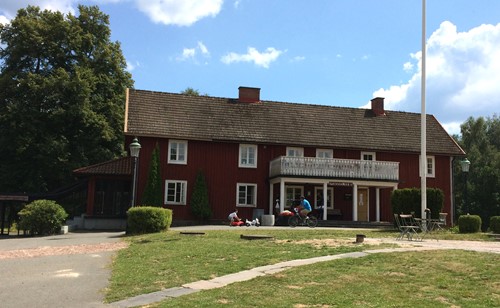
RECEPTION CENTER BREANÄS, SKÅNE
Integration
In 2010, an Establishment Reform (link to Swedish text) was enacted, which contains a 2-year Establishment Plan for refugees. The plan contained an agreement on 8 hours activity a day, including validation of education papers, job training, hobby activities, health, education etc. There is on-going access to social workers/consultants, but the onus is on the refugees themselves to organise a work placement or hobby activities for children.
If education is the primary focus of the Establishment Plan, there is however no demand for a job. The only ones who are exempt from the plan are those over 65 years of age and those deemed to have less than 25% ability to work. These will normally be given disability benefit by the council instead.
In all, refugees have the right to 525 hours of Swedish lessons (SFI), which are offered at four different levels and conclude with a final exam (this equates to ca. 11 hours a week for 1 year – much less than is offered in Denmark). Asylum seekers can also access Swedish lessons other places, but as a rule, these are run by volunteers. However, all of this gives bad results: after 2 years, just 4% are in ordinary full-time employment, the same as the totals for Denmark. After ten years in Sweden, roughly half have found employment and the average income is very low (links to Swedish text).
Public opinion
Despite the high level of unemployment among refugees, Sweden has maintained that from a long-term perspective, immigration is both profitable and necessary for Sweden, something which has also been supported by several calculations. However, in recent times, the pace has been too fast and Swedish society is having a hard time keeping up.
Public opinion has therefore also changed very quickly: until last summer, there was broad support for the open policy, but over the summer and autumn, Sverigedemokraterne (the Swedish equivalent of the Danish Peoples’ Party) stormed ahead in the polls. By February, however, the party was back on ca. 16% of votes as opposed to the Socialdemokraternes 25%.
In March 2016, there was 69% support for the harsh rules which the government have no enacted and refugees have become the most important topic among voters. However, every single one of the organisations that wrote hearing statements to the new law proposal, expressed criticism for it (links to Swedish text).
Economy
Asylum seekers are given a subsistence allowance by the Migrationsverket. If you live in a centre (food is provided, no access to kitchens), you get an allowance of 24 Swedish kroner per day. If you live privately, or in one of the Migrationsverket’s apartments, you get 71 Swedish kroner per day as a single adult, which has to cover all costs. Children and couples get a smaller amount per day.
When asylum is granted, an ‘establishment allowance’ is paid by the employment agency, (AF) once an Establishment Plan has been worked out. This equates to ca. 6,000 Swedish kroner per adult per month (before tax), if you participate in the Establishment Plan on a full-time basis.
A family with two children will (before tax) get ca: 13,000 Swedish kroner from the AF (2 adults) + 2,300 swedish kroner (2 children) + 4,000 establishment allowance (only for two years) = in all, 19,300 Swedish kroner.
If still not in employment after two years, you go down on ca. 2/3 of the benefit and lose the establishment allowance (in the family example: from 19,300 to 10,880 Swedish kroner).
A single adult with no children will go down to ca. 4,000 Swedish kroner, if s/he hasn’t found employment after two years, but can however be granted rent allowance (e.g. 1,700 allowance to cover a rent of 3,500 Swedish kroner).
You may study while on establishment benefits, but if you’re still completing your education after the two years are up, you must apply for a study loan as the Swedish student support is very low.
A Swedish citizen, who has not worked up the right to dole gets ca. 7,300 Swedish kroner per month (before tax).
Sources: migrationsinfo.se, migrationsverket.se, Svedala Kommun, nyidanmark.dk, dr.dk, svt.se, arbetsformedlingen.se


